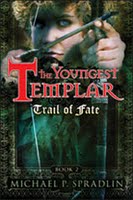
Every once in a while, I receive an arc from a certain editor. (Since this isn't a review site, every once in a while is about as often as I want to receive arcs.) I do get a little thrill when I find a package at the P.O. box, but when that package contains an arc as well as a paperback edition of an earlier book, I feel forewarned that what I'm looking at is a serial and that the editor is worried that I won't be able to figure out what's going on with the arc without having read another book first.
That was the case a few weeks ago when I found the arc for Trail of Fate the second volume in The Youngest Templar serial by Michael P. Spradlin waiting for me at the post office. The Youngest Templar is a hardcore serial set in the twelfth century. (I usually see serials set in fantasy worlds, so I thought the setting was interesting). The individual volumes are not traditional novels in the sense of a completed story line with a climax and resolution. In fact, the first book has no ending at all. The final words are "to be continued..." The second book has no beginning or ending, concluding with another "to be continued..."
Now, I've come to understand serials and that they are a different kind of reading experience, one that might be described as merging episodic television with reading. Though I must say that if I were really into a serial I would prefer to read it after the writer has completed the whole thing, the way many people prefer to watch a TV series on DVD rather than over the course of a television season.
But that aside, my question about serials is, as it was two and a half years ago, how do authors decide that they have so much story/plot that it requires more than one book to tell? Trail of Fate seemed a little padded to me. The bad guy from Keeper of the Grail was back, which made sense, but then another bad guy who was an awful lot like the first one appeared. And then we get a bad queen, too. A rather neat female character is introduced in book one and comes back in book two. Again, that made sense. But then a new female character who seemed a lot like the first one, in the sense of being a spunky, woman warrior type, shows up. It seemed as if they were just...taking up space in the plot. I felt as if I was killing time. If those characters and the events surrounding them had been left out, could the story have moved on in a faster and tighter fashion toward its finale--whatever that's going to be?
Plotting is a pain in the butt, anyway, and trying to do it over multiple volumes has got to be an ordeal. For instance, in the first book, Keeper of the Grail, the grail doesn't show up until the halfway point. And a couple of major characters come in even later. In a traditional book, those would be major flaws. However, when you're talking about a plot that's being stretched over several books, the halfway point of the first one is probably still early days.
But how does the author decide?
Given how much I hate plotting, I can't see myself writing a serial any time soon.
Trail of Fate will be published next month.
No comments:
Post a Comment